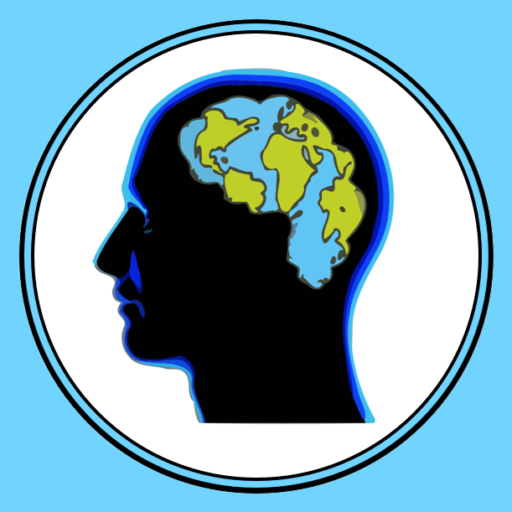
What is Copy Culture?
In ‘Take the Jester’, we discussed how puns pop up all over the landscape of meaning, and we described them as the ‘mushrooms of coincidence’. This because they pop up everywhere, with no meaningful pattern to show for it. All of which makes the pun a difficult subject to map out on our landscape of meaning, even if the use we then put them to is easier to define. But in the self-same landscape, there is, it turns out, a race of doubles that do exist as a meaningful family of entities. Meaningful not only in terms of their systematic occurence in certain and identifiable domains of our human culture, but also because they are easily and physically identifiable. For these ‘copies’ are tangible two or three dimensional physical conditions and objects that are both visible and relatively stable in the ever changing and generally abstract world of the human imagination, fit for both cartoons and the researcher into humour.
So here is an example from this family.
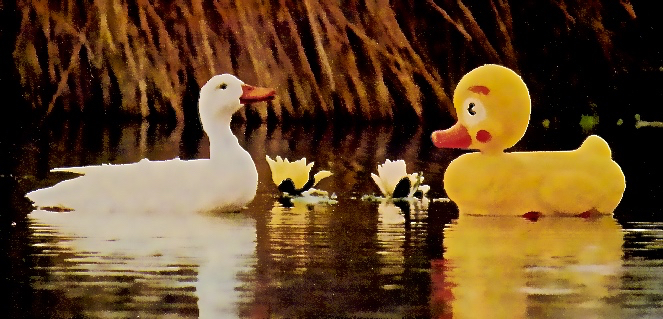
In the photo, we see two principal objects. One of these, the white one on the left, is easily classified by science as coming from Genetic Space, subcategory Kingdom Animalia, Phylum Chordata, Craniata, Vertebrata, Aves…. etc down to its specific Latin name. Or to put it in plain English, we are looking at a species of duck. But what about the other duck? The one made of yellow plastic? How does that get classified? Where does that belong in the scheme of things?
Well, we can start off by saying that the toy duck comes from the human realm of meaning that we are calling Social Space. We can also say that it is made up of the units of Physical Space (but processed by us to make plastic from the oil that has Genetic Space as its origin). However, these two steps do not take us far at all – just to the doorstep of our main problem, as it were. Because at this point, we still do not have a scientific address for the home of plastic ducks.
So where do we go from here? Where does the plastic duck belong in the greater scheme of things that is ‘Social Space’? ‘Toys Я Us’? The children’s bedroom? The baby’s bath? A toy shop window? Or perhaps the factory that made it? Then again, the source of the plastic duck is not the factory, but the human imagination, so perhaps we should look there?
Well, in the case of the photo above, where it is facing a real duck, and has been put there, on a real pond, by some unknown human agent, we can speculate on what is clearly a physical displacement. Could it be that the toy duck has taken on the rold of a decoy duck? Clearly not. Because firstly, its opposite number is a white farm duck, already under human control, and secondly, because the toy duck would be an abject failure as a decoy as long as it makes no attempt to look like the wild duck it is supposed to attract (it is significantly divergent in both shape and appearance). So what do we know? That this is a toy duck in the natural context of a domestic duck? Which gives us a displacement, with the normal context of the toy duck being a child’s bath? So that’s it then? We are looking at a toy duck. Which is perfectly fine as far as an everyday ‘address’ of this object goes, but at the same time, classifying a duck as a toy seems a little lacking in insight. The category ‘Toy’ is, after all, a colloquial one that, which may mean it is either misleading or at least too vague for our purposes. Certainly, the classification of the duck as a toy does not compare to the taxonomy of the real duck, in which the set of categories (Domain, Kingdom, Class, Order, Family, Genus and Species) can tell us a very great deal about where this duck belongs in the world of animals. So where do we go from here?
In fact, it turns out that this duck does belong to a well defined class of objects in Social Space, and it is convenient to refer to these objects as ‘Copies’. So the toy duck belongs to a subclass of the copy, that we can refer to as ‘toys’, and this subclass, along with other subclasses, such as ‘Art’ and ‘Scientific Models’ and ‘Fakes’ belong together, and make up what is the interesting and recognisable group of humanly created objects that we call ‘Copies’. And because copies do precisely that – copy something – we must include their originals in the overall relationship that we are now defining, so the area of human meaning we are looking at must therefore be referred to as the relationship between an:
‘Original and its Copy’ – otherwise known as – the ‘Original/Copy’ relationship
So, if we look back at our picture of the two ducks on the pond, we now see that the photo actually shows both sides of this relationship. That is, it shows the Original, in the form of a real duck, and its Copy, in the shape of a toy duck. And if there was a decoy duck there instead, or indeed an ornate and decorative duck, then these would be examples of a copy as well, both with the same original form of duck as their ‘inspiration’. Meaning that the same original can serve as the origin of a number of different forms of copy, some it seems more serious than others. All of which leads to the question: what other objects inspire the creation of copies, and how diverse are copies in practice?
According to a tale told by Pliny the Elder, the art of painting was invented by a Grecian maiden, who traced her lover’s shadow on the wall. Well, the story is open to question certainly, whilst the art of painting clearly developed many times in many different ways, but the actual idea is attractive enough. A shadowy image of the lover, made by the sun, is then turned into a material image, traced by the maiden, thus making a physical copy that has the merit of staying there, on the wall, long after the lover has departed. And this material image, made by the human hand, is just as much a copy as the toy duck, or the decorative duck on the mantelpiece, or the decoy duck on the lake.
If we add two dimensional pictures, like that of the lover or indeed the photo of the ducks on the pond, to our definitioin of the original/copy relationship, then we at once see that this relationship is much larger than the one represented by the three different types of duck. Taking this further, we can see that if copies can be both two and three-dimensional, then the relationship must include not only paintings and sculpture, but also all other forms of pictures, maps and charts as well. In fact, there are many other objects, such as models, stage sets, fakes, and imitations, that must also be added to our natural history of the copy, if it is to be properly complete. All of which makes up a gathering of forms that is large enough to suggest copies are an important part of the fabric of human culture. This being especially the case in copy-rich societies like our own, where technology has created a vast range and number of reproductions, material interpretations, and duplicates.
Like Pliny the Elder, we can speculate about where and how the first copies were created. Were they for example maps drawn in the sand? Or figures painted in caves? Or perhaps they began in a look alike face found in the nodule of a branch or stone, and treasured because of its likeness? We can even ask if the copy preceded the word and symbol, and whether its first function was mystical, practical or simply for amusement? But whatever the historical answer to these questions, one thing is going to become clear in this exploration of copy humour. Copies are common in cartoons (and it is by virtue of this ubiquity that I discovered their very existence, right there, in the heart of the landscape of meaning).
Why then do copies exist? Well, they are created by us to serve quite a wide variety of human purpose, but the fundamental point about copies is that they pick up new freedoms as a direct result of their new form and, at the same time, they can throw off some of the old restrictions of their original. We can refer to this double benefit of ‘new freedoms and loss of old restrictions’ as their ‘copy advantage’, and in the following list, some classic examples of this copy advantage are cited.
1) The copy offers its creator the opportunity to interpret and idealise experience in a way that transcends reality. The arts of drawing, painting and sculpture owe much to this important form of copy advantage. Statues of heros, and of religious leaders are examples of the way in which copies can idealise famous figures (and indeed make them ‘larger than life’, as in item 7).
2) The original may be scarce. The original Mona Lisa is unique, but by creating a poster copy of it, we can get over this rather extreme version of a scarcity problem. (Note, incidentally, that the original painting is itself a copy, in this case in terms of the woman who sat as there, as the original subject of the painting, right in front of Leonardo da Vinci).
3) The copy may be safer than the thing it represents. Toy guns and stage knives (with retractable blades) have relinquished just those properties for which their originals were designed, whilst dodgems enable us to crash cars without incurring legal or physical penalties.
4) The original may be expensive. Fake diamonds and forged money are both examples of copies, even though the latter lacks official sanction.
5) The copy may be used to overcome certain organic shortcomings. False teeth, glass eyes, fake eyelashes, wigs, prosthetic limbs and plastic flowers all help to circumvent the limitations of organic nature.
6) The original may deny access to itself for physical or social reasons. A military ‘mock-up’ of a target behind enemy lines is an example of this sort of copy advantage, as are certain erotic devices.
7) The original may be the ‘wrong’ size. Publicity models of products can be many times their original size, as can scientific models of a molecular structure, whilst the elephant costume in a fancy dress collection is necessarily much smaller than its original.
8) Humans are too precious to put in the firing line. When humans are the original, as for example in car accidents and war situations, then it is better to use copies of the body in the simulation of these events, as we do with crash test dummies, and flat picture targets of the enemy.
9) Animals can be fooled by authentic copies. The pair of opposites, ‘Scares’ and ‘Lures’, are common enough in Nature, but we too create them in order to achieve our own special ends. For example, in the shape of scarecrows and baits such as flies and plastic worms, and in the case of our decoy duck as well.
This list is just an introduction to the range of copy advantage in the O/C relationship. So it is not intended to look like a systematic study, that then fits into the bigger picture of how our meaning is organised. On the other hand, it is worth taking a quick look at the sort of questions it might raise, if only to get a taste of just how far short it falls in terms of scientific expectations.
So, the general question here is simply – how can we systematise this listing of copy advantage? That is, how can we summarise the limitations of those objects in our daily use that seemingly beget the need for copies? And for that matter, do these new freedoms, born of a radical change in composition and identity, turn out to be an aspect of those limitations found in such objects in the first place? Or are we approaching this from the wrong direction altogether? Should we instead determine why it is that we need to change reality in order to make, for example, the copy worlds of art and childrens toys? And what if we somehow manage to answer this question by finding a way in which both these worlds of art and toys fit into the bigger picture? Presumably thenthe questions drop a level, and focus on the particular and favourite objects that we enjoy making into, for example, toys, and explores the basis of such a bias. So, for example, would we not have to account for the fact that certain animals and certain wheeled devices account for an unnaturally large proportion of the toys that we make for our children? And having done so, again always with the aim of defining such a bias in a way that fits in with the bigger scheme of human meaning, are we then happy to just look at the various originals of toys in terms of their physical nature? With the practical aim that is, of assessing their physical features in order to catalogue their limitations for use by children? But would such an effort offer our goal of mapping meaning very much at all? Given that the physical nature of materials derives from the natural world of Physical Space, and is therefore about as far from the world of meaning as we can get? Well, it would help to have an understanding of the practical obstacles and possibilities open to the creator of new jokes about the Original/Copy relationship certainly, so clearly this endeavour, like the others above, would be worth the effort. And just as clearly, our list of copy advantage has a long way to go before we can be happy with its objectivity, precision and balance.
It seems we are very far from establishing the address of the yellow plastic duck. Yes, we can say it is a copy, and that it is an example of a well established domain within that class of phyically contrived double, namely a toy. We can also add that in this particular case, the copy has lost a number of the wild and uncontrollable traits of its original (so thankfully, it neither pecks nor shits for example), and that it has gained certain others (such as its cute appearance and squashy form) as But then what? For that still leaves us in the realm of common sense, where we are still using familiar terms in our language to cover the few distinctions we have managed to come up with in order to define the duck. Mind you, discussion about the pattern of the ‘Original/Copy relationship’, and the notion of ‘Copy Advantage’ both seem to go somewhat beyond that point to something a little more interesting, so there is progress to be made just there perhaps. Meaning that we should explore the natural history of the Original/Copy relationship a little further, and see where it leads.
So called ‘Western Culture’ might be described as ‘Copy Rich’, because once humans reach a certain level of technology and wealth, they surround themselves with copies of all sorts. (Which is not to say that tribal culture does not find the copy important, because they make toys for their children, and art for their observances to the very limit of their technology). Indeed some areas of this culture are absolutely full of copies. We only have to think of such places as art galleries, toyshops, theatres, film sets, fairgrounds, fun-parks, and religious places of worship to realise that we really are, as a race, heavily into all the possibilities that this relationship offers up to an intelligent life form. There are also many other copy categories, such as maps, board games, puppets, fakes and forgeries, lures and baits, scientific and educational models, and dummies (shop, ventriloquist, tailor’s, crash-test, target and scarecrow) that are also very common, although they may not fall into such convenient spatial categories as say an art gallery or a toyshop. But wherever they are, one thing is quite clear: these, as it were, humanly created ‘puns’, are not like mushrooms that pop up just anywhere. Because instead they make up a sensible category of objects, that are created and allocated to the various places in our social landscape based on a strict pattern of human purpose and design. So not only can we explore how the copy is used in humour, just as we can the pun, but we can also go further, and explain their identity and distribution as well. Because copies are very far from being the products of chance, and they are, in fact, an important aspect of the applied science of meaning.
Now let us take a look at the following cartoon, drawn up for me by my good friend, Andrew Ball.
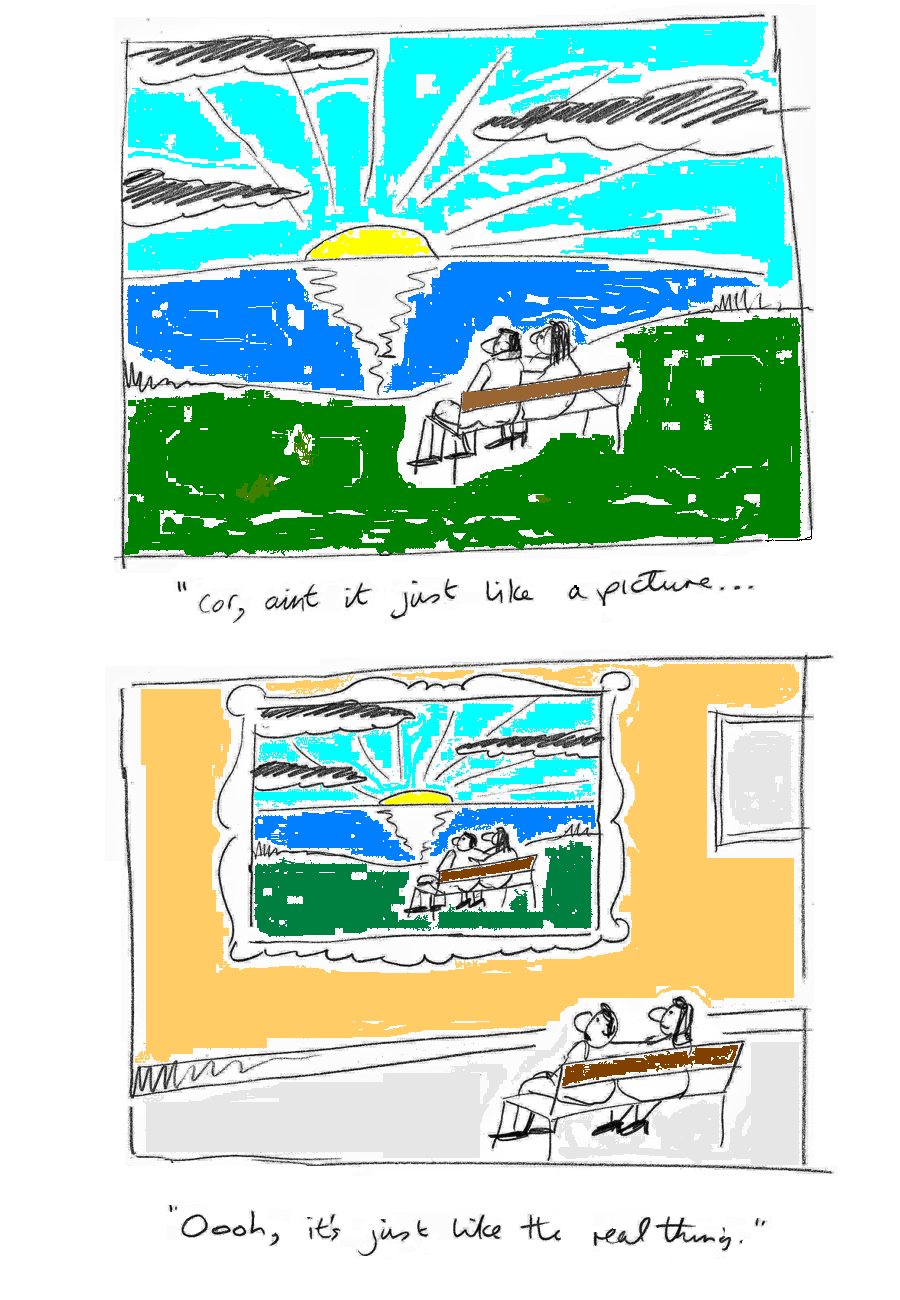
The couple gaze at the sunset, and coo like doves over its similarity to a painting (‘Cor, ain’t it like a picture’). Why? Because painters tend to choose nice compelling subjects for their work, and the sunset is a clear winner in this respect. The result being that when we see the real thing, we may find that it is actually the copy made by the painter that is the more familiar version of this particular scene (especially given that urban man barely gets to see the sky at all, let alone in panoramic view). So it makes sense to compare reality to its copy in this case. Because yes, it is just like a picture.
The couple in the art gallery are entranced by the literal realism of the painting in front of them. Copies imitate their originals, and are often judged by the extent to which they achieve this ‘copying fidelity’, so a painting that succeeds in capturing the likeness it seeks to represent must, at least in the conventional wisdom of common sense, be doing a great job. So it makes sense to compare the copy to its original. Because yes, it is just like the real thing.
It is when we see these two points of view together in the cartoon above that we see an example of the true symmetry of the two realities proposed in the graphic with the worlds and heads in the introduction. For the world of the imagination is on a par with the world of Physical Space insofar as humans are concerned, and this is surely what allows us to see a painting, and its original landscape as somehow equal, with each representing just half of the whole story that is the human experience. But of course not really, because when it comes down to it, physical reality precedes the fabrications of mankind, and exists without qualification of any kind. Thus the painting can be judged by its similarity to the reality it copies, and although it seems the opposite is also true (so the success of the sunset is qualified by its comparison to a humanly created picture), in fact this is not quite so. Because we humans always have our feet on the ground, and know what comes first, even if we like to elevate our own secondary creations above this. For example, much of the art movement is now based on our graphic arts NOT representing reality as closely as they might. A sensible move given the ubiquity of the exact representations produced by modern camera technology it must be said. So an impressionist painting conveys the reality of a poppy field as seen and felt by its human participant, rather than the poppy field captured in a photo. Which is to say that the copy is elevated above the literal minded view of the physical reality of a poppy field in the eyes of its human audience, although we all still know what came first.
Credit is due to Adam Johnstone, then an undergraduate at Oxford, and one of my most brilliant students, who pointed this example out to me (as being ‘grist to my mill’), and certainly its power in pointing out the true equality of the Original/Copy relationship is hard to beat. Because what this image does is to dramatise both sides of the Original/Copy coin at the same time, doing so through this comparison based on symmetrical self reference. So reality is just one side of the story, whilst in this case, art is the other. Because we humans are just as likely to judge a landscape by its similarity to the pictures we have seen in the past as the other way around. Indeed, it seems that in the subjective world of Social Space, the reality of copies is so considerable that it often has an equivalent status with the real world outside it. Which reminds me of one of the Oxford entrance questions in a general paper one year:
‘Is Nature ever as beautiful as Art?’
One can be both indignant and amused at the tacit audacity of this question. Because how could anyone even begin to think that the range of scale, complexity, richness and overwhelming vastness of nature could ever ever be compared to the smallness of human art? And yet that comparison does somehow hold water in the human scheme of things, where for all its impressive scale and magnificence, nature is nevertheless secondary to how we see it through our art. How, after all, could nature ever compare to the fantastic wealth of meaning that we find in a great cathedral or palace, full of architectural virtuosity, fine furniture and paintings, statues, tapestries, stained glass and carpets? Surely, we might argue, the coldness of space, the indifference of plants, and the ‘dog eat dog’ domain of the food chain is no equal to, for example, the purpose, hope and joy we find in a beautifully planned city or in a painting by an impressionist? Because for us humans, it seems, the copy can often take priority over its original, even though natural logic, based on which came first, tells us it is the original that always comes first.
The fact is, we humans revel in our Copy Cat Culture. For example, if we look at the following photo of the famous Sacre Coeur up on the top of Montmartre, in Paris…
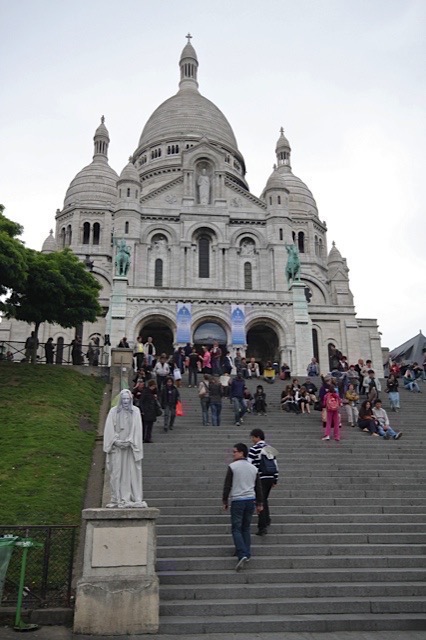
And then we take a closer look at the statue on the left hand side…. which as you may have already noticed, now seems to have changed its posture…
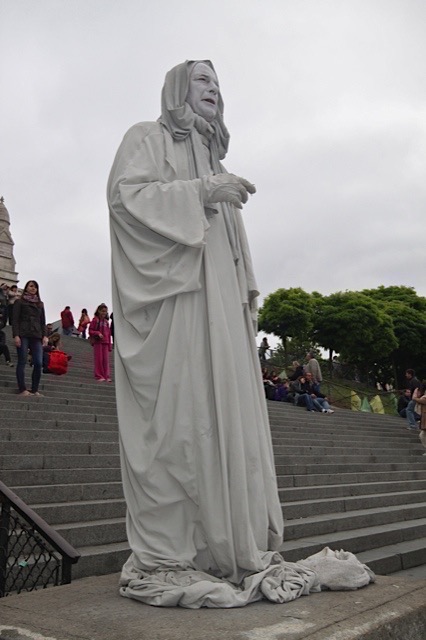
Because of course it’s no statue at all, but a man standing very still, in a sheet, with his face painted white. Making money from the tourists in this case. And this is an act worth that money because we all love the idea of a statue, that is a real man, that is a statue. As we can see in the final shot of this sequence below.
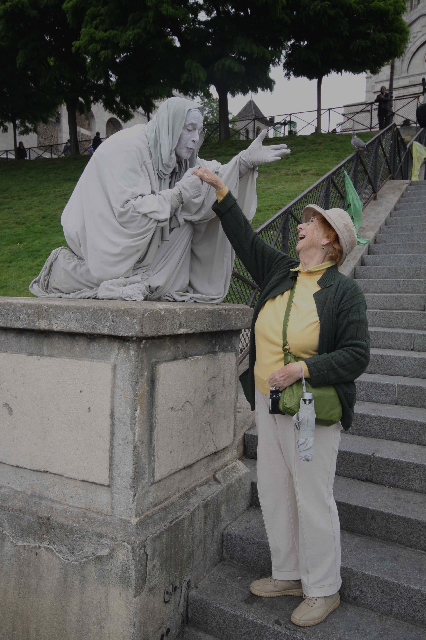
Enough, at any rate, to keep him rather well remunerated for standing there all day. And here’s another example, appropriately sited outside the Louvre museum, up against a wall, with a curtain hiding the rest of the body (and the support structure for the heavy frame), from public view.
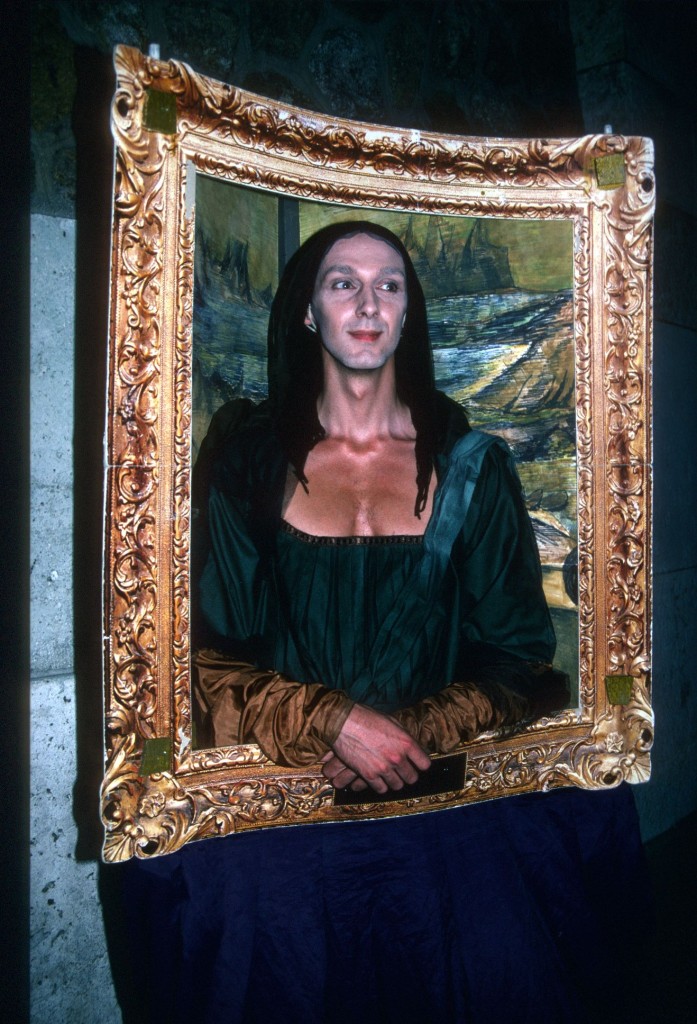
The Mona Lisa of course, but outside, on the pavement. A street artist copy of an icon so revered that the original (copy) lives behind bullet proof glass in a well secured gallery inside the Louvre. A copy that in this case is a living being, with his hands deliberately clasped over the frame in a three dimensional declaration of ‘The Original IS The Copy’. True, there is more to it than that because the lady Lisa is, in this case, a young man, so there is also a gender twist to include in our impact assessment. But the main reason that this living ‘tableau’ is of interest, again to the tourists (but they’re people aren’t they?) comes down to the idea that this famous painting has come alive in an unexpected and intriguing way.
Seriously though, when one watches the reactions of people to the painting or indeed to the statue above, it is quite surprising just how much they are fascinated by them, especially given the ubiquity of copies in this copy-rich culture that most of us now live in. The tourists just stand there, gazing at the ‘painting’, often riveted to the spot, smiling at its duplicity with evident pleasure. And if ‘time spent in front of’ is anything to go by, then it would seem that they are often more compelled by this tableau, outside in the street, than they are by the real Mona Lisa just nearby in its hallowed gallery in the Louvre. But then, for most of us, the work of the humorist has always had far more immediate appeal than the serious undertakings of the artist…
At this point, it is useful to take a quick glance at the scale of the challenge in identifying the range of copy natural history in our culture. This will be considered further in the subsection on how to map copy variety at the end of this whole section on copies, but here is a cartoon drawn up for me by Matt Philips, using just one source of original, namely, the human body.
A Copy Collection – The Human Figure

Clearly the original basis of all these copies is the human body, and given the central importance of our own and others bodies, it is not surprising that we should copy it in so many different ways. Note too that this cartoon presents us with only a small collection of the possibilities presented to us by reality, and that it ignores the copies of parts of the body, such as prosthetic limbs, wigs and false eyelashes. In other words, it is by no means exhaustive.
Within this tight boundary of the body, we find a number of copy domains represented through the focus of the human body. For example, the publicity model at top left uses a two dimensional board to advertise a theatre production, and such copies are usually larger than life, as well as making the alternative of a real human standing there, in its place, quite unnecessary (except of course when it is). Then, in front of this figure, we have a statue that looks like the famous ‘Thinker’ by Rodin, from the huge copy domain of two and three dimensional interpretations that make up the world of Art. In front of which we see a religious icon, in the form of the Buddha, as an example of how copies can become sacred representations of famous figures (or celebrate famous heros quite outside the religious domain). To the right of the Buddha is a cliche of mantelpiece decoration – the Spanish flamenco dancer, which is not so much deemed as Art, as Ornament (more abstract motifs, such as the Acanthus leaf, are also common in this domain). Next is a toy soldier, from that other huge copy domain of Toys. A domain that has now spun off a number of feature length animations that feature a whole world of living toys to entertain not just children but adults too. Then we find a Voodoo doll, which is a copy that mediates magical transactions, supposedly by making a causal connection between the copy doll and its chosen original.
Meanwhile, with the yellow crash test dummy, we see an example of how we use copies as stand-ins for our precious human body, for times when it is subjected to danger and damage. On a less serious note, the ventriloquist dummy is a copy of a figure that represents a purportedly living being, animated by its owner and serving as the repository of his thrown voice, all for the purpose of entertainment. Whilst the scarecrow is a classic example of how the copy can be used as a fake in our relations with the natural world, and in this case, it is used as a scare, rather than a lure. Behind the scarecrow is a shop mannequin that serves to show off clothing (live models do the same, but they are much more expensive, and very ‘fussy’ about their conditions). The Punch and Judy hand puppet fits in with the ventriloquist dummy in that is intended to entertain, though some puppet shows have a more serious aim in mind, so it belongs in the copy domain of theatre. Then there is a blow up sex doll included here, for good measure as it were (‘the original may deny access to itself for physical or social reasons’). So that makes twelve copy figures in total, with others having been omitted from the composition due to a lack of space (such as an acupuncture doll to show where to stick those pins, and a robot, and a silhouette of a man serving as a shooting target, these three representing the loose categories of Teaching, Technology and Warfare).
So once again, we find ourselves using these familiar colloquial groupings, such as ‘Toys’, ‘Art’ and ‘Theatre’, and yet they are somewhat loose, and certainly nowhere near as definitive or as systematic as we will need for a science of meaning. In fact, it may be better to look at the O/C relationship in terms of the list of nine copy advantages at the start of this sub section, rather than through these more conventional categories. Because at least the idea of copy advantage is analytical, and gets to the point about the logic between the copy and its original. Well, more on this subject at the end of the section on Copies. However, it is useful to appreciate just how rich copy natural history actually is, even at this early stage, because that is one of the ways in which it leads to such rich pickings in the creation of copy humour.
Probably one the best ways of finding out more about our Copy Culture is through humour. Which in this case means going through a number of the cartoons to be found playing around in this part of the landscape of meaning. So what do we call this area? ‘Copy Cat Park’? Because, like a real park, there is a range of different kinds of copy experience on offer. True, parks may vary a good deal, but children’s play areas, fun fairs, and art exhibitions, along with outdoor theatres and, in many countries, shrines of religious observance, are all found in parks around the world, so the park image is sound. Then again, what about calling this area the ‘Copy Plateau’? Because when I first began to visualise this area more closely, the term ‘Copy Plateau’ seemed to echo the landscape metaphor rather well, and was the one I used. And the fact that I was referring to a neighbouring part of this topography as the ‘Valley of Shadows and Reflections’, only added to this overall picture, because now we had both a plateau and a valley in view, and this seemed to work well.
But in the end, the idea of ‘Copy Park’ has it over ‘Copy Plateau’ because of the profound difference between on one side, the humanly created copies of the human world, and on the other, the shadows and reflections of the physical world. A park is an integral part of the human world, so the park is appropriate to the O/C relationship in a way that the physical plateau is not. At the same time it is appropriate to refer to the home of images, made by light and its absence, as a valley of reflections and shadows because images are created by the forces of the physical world. So maybe the best thing is to imagine that ‘Copy Park’ stands on a naturally occurring and raised area of terrain, thereby known as the ‘Copy Plateau’.
At which point, we are free to enter the park, and roam amongst the many forms of copy, in order to see how humour plays with not only the copies themselves, but also with the originals that inspire their creation in the first place.
